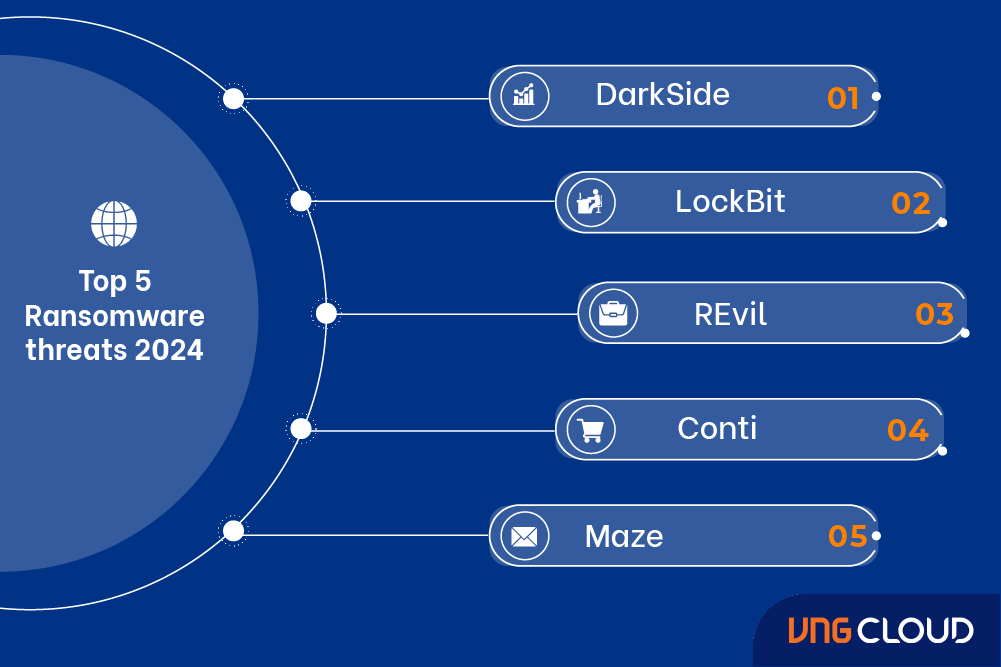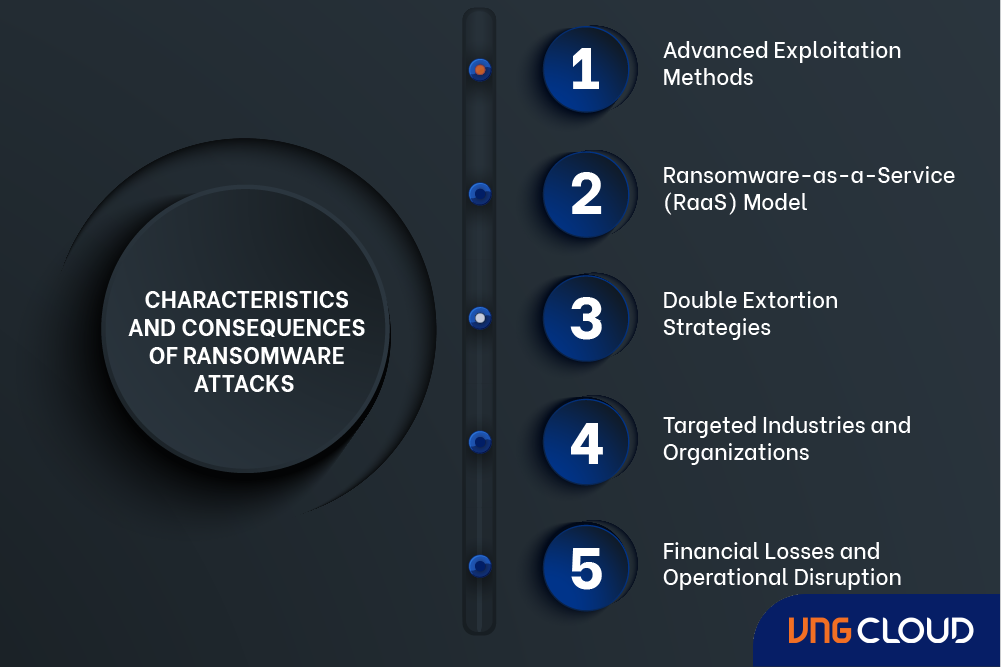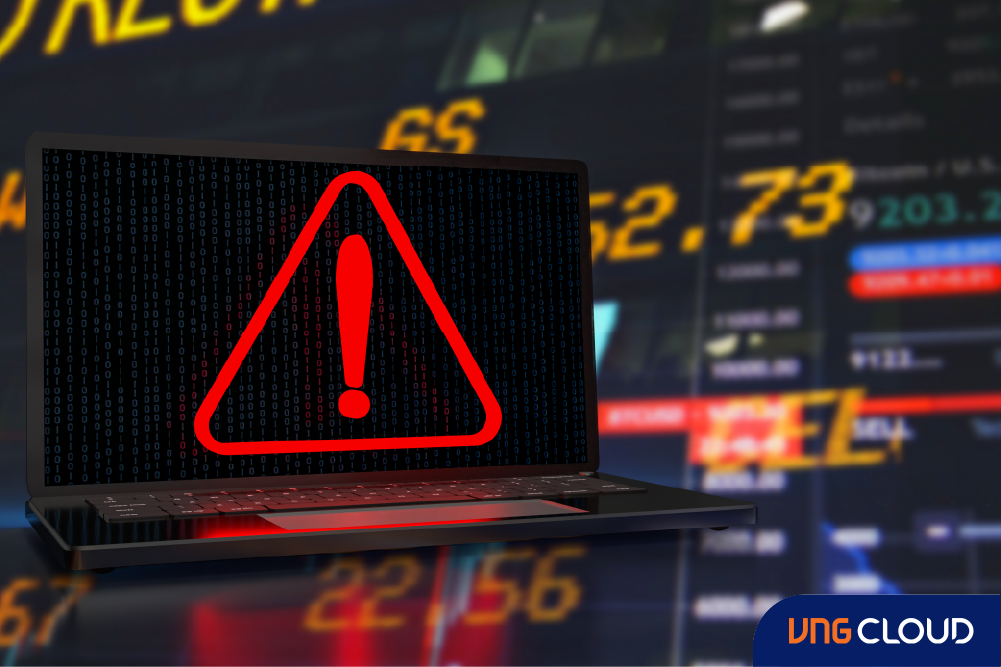In today’s digital environment, the threat of ransomware attacks casts a formidable shadow, presenting a significant threat to both organizations and individuals. Renowned for their capacity to breach systems, encrypt critical data, and demand substantial ransoms for decryption, these malicious campaigns have garnered widespread attention.
As we step into 2024, it becomes imperative to remain vigilant and abreast of the changing landscape of ransomware assaults. Through awareness, we can enhance our ability to mitigate risks, protect our data, and ensure the uninterrupted operation of our digital infrastructures.
This article will explore the top five ransomware attacks anticipated in 2024.
Top 5 Ransomware Threats in 2024

1. DarkSide
In the shadowy depths of the cybercriminal realm, DarkSide has risen as a formidable menace. Renowned for its sophisticated methods and impactful assaults, this ransomware group has garnered significant attention from cybersecurity specialists and organizations worldwide.
Key aspects of DarkSide include:
- Operating as a notorious ransomware-as-a-service (RaaS) entity.
- Targeting prominent organizations employing advanced tactics.
- Infamous for orchestrating high-profile attacks on critical infrastructure.
2. LockBit
LockBit has quickly gained notoriety as a substantial menace to global organizations. This cunning ransomware-as-a-service (RaaS) syndicate has mastered the fusion of file encryption with data theft, employing dual extortion strategies to heighten their influence.
Here are some key aspects of this group:
- Rapidly emerged as a big threat from 2019.
- Use double extortion tactics involving file encryption and data theft.
- Concentrates on high-value organizations, prioritizing swiftness and effectiveness.
3. REvil
REvil emerges as a prominent and financially lucrative entity. Also recognized as Sodinokibi, this cybercriminal syndicate has garnered attention with its advanced strategies and notable breaches.
Key aspects of this group include:
- Operating as an active and financially successful ransomware organization.
- Executed a supply chain attack on Kaseya in 2021.
- Anticipated to refine tactics and broaden operations in 2024.
4. Conti
This ransomware faction has established its presence by directing its attacks towards organizations, notably in the healthcare field, causing widespread disruption to their digital framework.
Here are some notable aspects of this group:
- Primarily targets the healthcare sector but also extends its reach to diverse industries.
- Functions as an affiliate-based ransomware collective.
- A versatile threat anticipated to endure throughout 2024.
5. Maze
In the history of ransomware, the Maze ransomware group is remembered as a trailblazing entity that reshaped the cyber threat landscape. Although the original Maze group has disbanded, its influence persists through the rise of imitating successors. These successors have adopted comparable methods, causing chaos for organizations globally.
Key points about this group include:
- The original group has retired, but copycat successors have emerged.
- They pioneered data exfiltration and the threat of data release.
- The tradition of data extortion attacks is anticipated to persist in 2024.
Characteristics and Consequences
In today's threat landscape, it's vital to comprehend the characteristics and consequences of ransomware assaults. Notorious groups like DarkSide, REvil, Conti, LockBit, and Maze utilize sophisticated techniques and strategies.
These encompass advanced exploitation methods, the Ransomware-as-a-Service (RaaS) model, double extortion tactics, specific industry targeting, and substantial financial losses coupled with operational disruptions.
By understanding these features, organizations can proactively bolster their cybersecurity defenses and mitigate the threats posed by ransomware attacks.

1. Advanced Exploitation Methods
DarkSide, REvil, Conti, LockBit, and Maze, renowned ransomware factions, employ sophisticated exploitation methods to infiltrate systems. They capitalize on software, network vulnerabilities, and human errors to gain illicit entry.
These advanced tactics enable them to circumvent security protocols, penetrating targeted organizations with higher success rates. This underscores the importance for organizations to remain abreast of the latest vulnerabilities and promptly implement patches and updates to mitigate the risk of exploitation.
2. Ransomware-as-a-Service (RaaS) Model
DarkSide, REvil, and LockBit adopt the Ransomware-as-a-Service (RaaS) framework, offering their ransomware software to other threat actors. In return, these actors execute attacks and receive a portion of the ransom payments.
This approach facilitates rapid scalability for these groups and expands the breadth of the threat landscape. Consequently, organizations must recognize that ransomware attacks may originate from various actors, necessitating readiness for potential attacks from diverse sources.
3. Double Extortion Strategies
LockBit, REvil, and Maze are recognized for their utilization of double extortion strategies. Beyond encrypting files and demanding ransom payments, these groups also extract sensitive data from their targets. They leverage the threat of exposing this stolen data if the ransom demands are not met, intensifying the pressure on organizations to comply.
This approach presents a notable threat to organizations, as it can result in reputational harm, legal ramifications, and erosion of customer confidence. It emphasizes the necessity of implementing robust data protection measures, such as encryption and secure backup solutions, to minimize the potential fallout from data breaches.
4. Targeted Industries and Organizations
Different ransomware groups display preferences for particular industries and entities. For instance, DarkSide has a penchant for critical infrastructure, whereas Conti sets its sights on healthcare organizations.
Understanding these targeted sectors enables organizations within them to remain especially vigilant and introduce extra security measures.
It's vital for these entities to conduct comprehensive risk assessments, establish robust cybersecurity protocols, and allocate resources to industry-specific threat intelligence to mitigate the risk of ransomware attacks.
5. Financial Losses and Operational Disruption
Ransomware attacks have the potential to cause substantial financial losses for organizations. Beyond the ransom demand, organizations may face expenses related to incident response, system recovery, legal proceedings, regulatory penalties, and harm to their reputation.
This underscores the importance for organizations to allocate resources toward cybersecurity measures, adopt dependable backup solutions, and formulate thorough incident response strategies. Preparing for the financial ramifications of a ransomware attack can aid organizations in mitigating the consequences and facilitating a more seamless recovery process.

Key Takeaways
In this dynamic environment, knowledge serves as the cornerstone for outpacing cybercriminals. Staying informed about top ransomware attacks for 2024 empowers organizations to strengthen their defenses, safeguard valuable data, and mitigate financial risks.
Through a comprehensive approach encompassing robust security protocols, employee training, incident response planning, and industry collaboration, we can collectively combat ransomware threats and foster a more secure digital landscape for businesses and individuals.
Here are some actionable tips to defend against ransomware:
- Stay proactive and well-informed to mitigate the risks posed by ransomware attacks.
- Implement resilient cybersecurity practices to safeguard valuable data and reduce financial vulnerabilities.
- Emphasize data protection, deploy backup solutions, and establish incident response strategies.
- Maintain vigilance and adapt security measures as ransomware threats evolve in 2024.
Protect your entire business ecosystem with VNG Cloud solutions. We safeguard every data resource, from cloud infrastructure, SaaS & internal applications, databases, personal laptops, to virtual machines (VMs), and on-premises data. Contact us today for free consultancy!